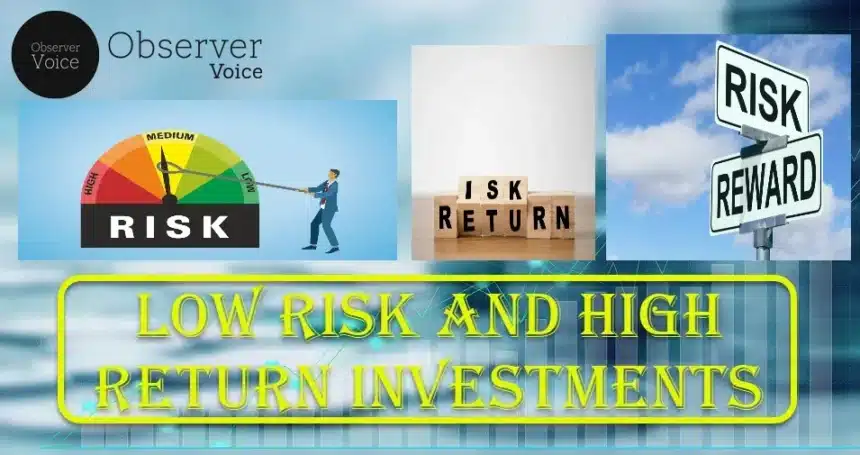Risk and reward are the yin and yang of investing. In investments, you can’t have a return without taking on some risk. Both are always present, though it is certainly possible to reduce your risk and increase your reward if you follow the right investment strategy i.e. low-risk and high-return investments.
Let’s look into a better understanding of what investment risk is, the types of risks we’ll face with our holdings, and how we can do risk management. If anyone says that they want maximum returns on their investment without taking any risks, then they don’t have much knowledge about investing. Risk is like the speed of a car. As the speed of a car increases, you’ll go just as fast, but along with that, the chances of getting into an accident increase.
Why Risk Taking is Important
The people who are financially literate and want to think and learn about money, the chances of them investing also increase. A lot of people who don’t want to take any risks mostly keep their money in a savings account or FD (Fixed Deposits). And there’s nothing bad about it. But it won’t give many returns on it, and maybe due to inflation, money might become less. Responsibilities and the home atmosphere also affect the chances of taking a risk. Research says that for people who talk more about money in their household, discuss finance, there the chances of people investing increase. The Ability to take a risk also depends on your goal and family situations. If the responsibility of earning for the family is on you, then you might not want to take many risks. But if you are 20 years old and just starting your investing journey, then maybe you’ll be able to take a risk. So today we’ll see why different investments have different levels of risk. Risk and Returns are like a pyramid. There are 3 categories ‘Low Risk, Low Returns’, ‘Medium Risk, Medium Returns’, and ‘High Risk, High Returns’.
So first let’s understand ‘Low Risk, Low Returns’, Mostly these investments are debt investments. In this, Money is given as debt and for this, the other person will give interest. Money can be given as a debt to the bank as an FD (Fixed Deposits), or as a debt to a company or government through Bonds. What is ‘Bonds’? Money is given as a debt through Bonds and for a fixed time you’ll keep getting interest. After the time is over, you’ll get your money back. Here the risk is that the person who has taken the debt won’t be able to pay the money back.
Now, let’s understand ‘Medium Risk, Medium Returns’, If someone bought the shares of a company from the stock market, then a small part of their company is bought. If their company is doing well, business is going well, then the value of shares can also increase. But if that company is not earning money, their performance is not well, then the value of shares can decrease. The risk here is that, due to the movement of the market, the value of shares can go up and down.
Read More: Personal Finance Basics
Finally, let’s understand ‘High Risk, High Returns’. Companies like ‘OLA Cabs’, ‘OYO Rooms’, ‘Flipkart’ are very big today, but when investors invested their money in them, these companies were very small and there was no track record of them. Investors saw the potential and ideas of these founders and invested in them. But most of the time, these start-ups are not successful, that’s why the risk here is high. These ‘High Risk, High Returns’ investments are done through professionals.
Risk Management
Beginner investors are scared of risks. Experienced investors understand risks and go ahead. A good way of managing risks is ‘Diversification’. Diversification means investing money in different places to minimize losses. Now let’s take an example to understand it. Suppose Someone bought the shares of an airline, there was a lockdown, and flights stopped working. The business of these airlines has reduced and that’s why the value of the shares may decrease. If the shares of the airline are only bought, then the value of the investment will decrease. But along with that if the investment is made in different sectors, then the risk will be reduced. Diversification can be done not only by investing in different sectors but also by buying different investment products. If your investment is in Shares or Equity where you are buying a part of the business, then you can make some investment in debts or loans where your risk level is lower. In this way, by taking different products you have to make a basket, which will manage risk and will protect you from losses. Another way of managing risk is to go for ‘Managed Investments’ and let a professional handle investment. These funds, after collecting money from investors, conduct research and choose which products and shares should invest in. For this service, they charge a small management fee. But you are assured that the person who’s investing your money has knowledge of both product and market. An example of these managed investments is Mutual Funds, Debt Funds, and Gold Funds.
What is alopecia? It’s no laughing matter for millions of Black American women

